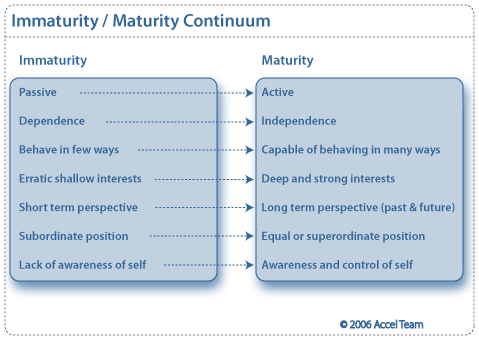Throughout time there have been many psychological theories that have touched upon aspects of maturity. However, it is rare to find a theory that has maturity as its main focus. The Maturity Theory created by Chris Argyris is one of these few. In this case, the purpose of the theory is to explore maturity in regards to organizational environments. Looking at the concept of maturity through this scope can be useful as it makes clear distinctions between what are key aspects of being mature and of being immature. The comparison of ‘opposite’ reactions or components makes it simple to understand. Moreover, the fact that maturity and immaturity are seen as a continuum makes it a more realistic theory.
The first of the seven changes that is meant to take place in this transition to a more mature employee is: Passive –> Active. What this means is that rather than simply doing what they are told to do and nothing else, when people start becoming more active they take more initiatives for themselves. In this case, proactivity to start a new project or to go beyond what is asked of you is a good indicator of maturity.
The second change is: Dependence –> Independence. Although an adult person may already independent in many aspects of their lives, independence at work is also important, and therefore an indicator of maturity. In this case, independence is not mutually exclusive with teamwork. Rather, it refers to being able to work, alone or in a group, but always contributing in a significant way.
The third change is: Behaving in few ways –> Behaving in many ways. As we become more mature, it could be argued that we also become more flexible and adaptable. This change in regards to growing older, may also relate to the fact that we are exposed to more situations and have more experiences. In the workplace, this flexibility translates into being able to do your job well but also being able to help out when anything different from what you are meant to be doing is needed or required.
The fourth change is: Casual and shallow interest –> Deeper and stronger interests. Although this distinction between types of interests may be a subjective one, it basically refers to the general difference between interests that are considered more ‘immature’ or ‘mature’. For example, the difference can be seen between children who may have more materialistic interests such as toys and adults who may have more meaningful interests such as making the world a better place. However, age is obviously not the only indicator of this aspect of maturity, as there are many adults who have what could be seen as ‘immature’ interests. But in the organizational setting, an ‘immature’ interest could be doing the job or being interested in the job only for the money, while a more ‘mature’ interest is doing the job because you are passionate about it.
The fifth change is: Time perspective includes only present –> Time perspective involves past and future too. When looking at maturity in all kinds of settings this point is quite debatable since there are many authors that argue that being able to focus on the present is something that makes a person mature. However, since this theory focuses on the workplace, I think this aspect of maturity in this context refers to things such as being able to have more perspectives on different problems, thinking ahead and learning from past mistakes.
The sixth change is: Subordinate positions –> Equal or superior positions. If individuals are ‘immature’ in this sense, the dynamic of relationships to others could end up being as “secondary” or “less valuable”. However, this point refers to how companies should strive for the relationship between two individuals in the workplace to be seen as either equal or somewhat superior but always with mutual respect.
The seventh change is: Little awareness of “self” –> More aware and in control of “self”. I think that this point is more straightforward, since most would agree that more self-awareness and self-control are indicators of maturity. In the organizational context, what this is most likely referring to though is that a mature person should be more aware of the ways in which they work best for instance and also have the self-control required in order to achieve goals in certain amounts of time for example.

All in all, the main aim of the theory according to Chris Argyris is that it should encourage the management within companies to empower their employees by providing “opportunities for personal growth in the same 7 areas in which children must mature as they approach adulthood” (Dininni, 2011). Ideally, through this approach employees will begin to move along the continuum more towards ‘full’ maturity. However, in my opinion, the idea of achieving “full” maturity is quite complex and much more difficult than it may seem. I wonder: Is it even possible to achieve this? Even within the organizational setting?
Sources:
Argyris, C. (2006). Immaturity / Maturity Motivation Theory. Retrieved November 23, 2016, from http://www.accel-team.com/human_relations/hrels_06ii_argyris.html
Dininni, J. (2011, December 28). Management Theory of Chris Argyris. Retrieved November 23, 2016, from http://www.business.com/management/management-theory-of-chris-argyris/
Nunes, P. (2016, February 23). Argyris Maturity Theory. Retrieved November 23, 2016, from http://knoow.net/en/economics-business/management/argyris-maturity-theory/

